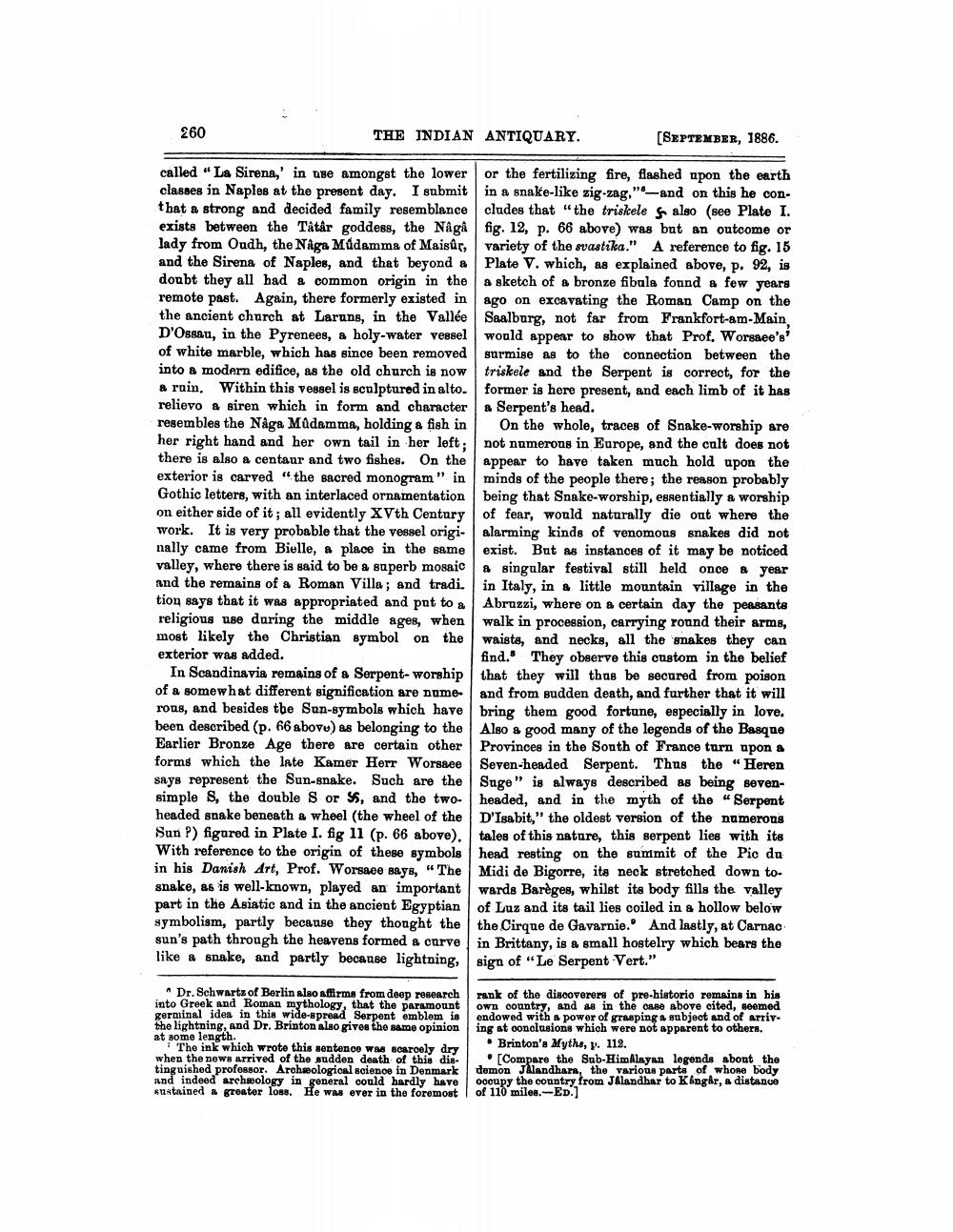________________
260
THE INDIAN ANTIQUARY.
[SEPTEMBER, 1886.
called "La Sirena,' in use amongst the lower or the fertilizing fire, flashed upon the earth classes in Naples at the present day. I submit in a snake-like zig-zag, "l-and on this he con. that a strong and decided family resemblance cludes that "the triskele also (see Plate I. exists between the Tâtâr goddess, the Nâgâ fig. 12, p. 66 above) was but an outcome or lady from Oudh, the Naga Mádamma of Maisûr, variety of the svastika." A reference to fig. 15 and the Sirena of Naples, and that beyond a Plate V. which, as explained above, p. 92, is doubt they all had a common origin in the a sketch of a bronze fibula found a few years remote past. Again, there formerly existed in ago on excavating the Roman Camp on the the ancient church at Laruns, in the Vallée Saalburg, not far from Frankfort-am-Main D'Ossau, in the Pyrenees, a holy-water vessel would appear to show that Prof. Worsaee's' of white marble, which has since been removed surmise as to the connection between the into a modern edifice, as the old church is now triskele and the Serpent is correct, for the a ruin. Within this vessel is sculptured in alto. former is here present, and each limb of it has relievo a siren which in form and character a Serpent's head. resembles the Naga Mûdamma, holding a fish in On the whole, traces of Snake-worship are her right hand and her own tail in her left; not numerous in Europe, and the cult does not there is also a centaur and two fishes. On the appear to have taken much hold upon the exterior is carved "the sacred monogram" in minds of the people there; the reason probably Gothic letters, with an interlaced ornamentation being that Snake-worship, essentially a worship on either side of it; all evidently XVth Century of fear, would naturally die out where the work. It is very probable that the vessel origi-alarming kinds of venomous snakes did not nally came from Bielle, a place in the same exist. But as instances of it may be noticed valley, where there is said to be a superb mosaic & singular festival still held once a year and the remains of a Roman Villa; and tradi. in Italy, in a little mountain village in the tion says that it was appropriated and put to a Abruzzi, where on a certain day the peasants religious use during the middle ages, when walk in procession, carrying round their arms, most likely the Christian symbol on the waists, and necks, all the snakes they can exterior was added.
find. They observe this custom in the belief In Scandinavia remains of a Serpent-worship that they will thas be secured from poison of a somewhat different signification are nume- and from sudden death, and further that it will rons, and besides the Sun-symbols which have bring them good fortune, especially in love. been described (p. 66 above) as belonging to the Also a good many of the legends of the Basque Earlier Bronze Age there are certain other Provinces in the South of France turn upon a forms which the late Kamer Herr Worsaee Seven-headed Serpent. Thus the “Heren says represent the Sun-snake. Such are the Suge" is always described as being sevensimple S, the double S or SS, and the two- headed, and in the myth of the “Serpent headed snake beneath a wheel (the wheel of the D'Igabit," the oldest version of the numerons Sun?) figured in Plate I. fig 11 (p. 66 above). tales of this nature, this serpent lies with its With reference to the origin of these symbols head resting on the summit of the Pie du in his Danish Art, Prof. Worsace says, “The Midi de Bigorre, its neck stretched down tosnake, as is well-known, played an important wards Barèges, whilst its body fills the valley part in the Asiatic and in the ancient Egyptian of Luz and its tail lies coiled in a hollow below symbolism, partly because they thought the the Cirque de Gavarnie. And lastly, at Carnac sun's path through the heavens formed a curve in Brittany, is a small hostelry which bears the like a snake, and partly because lightning, sign of "Le Serpent Vert."
Dr. Schwartz of Berlin also affirms from deep research into Greek and Roman mythology, that the paramount germinal idea in this wide-spread Serpent emblem is the lightning, and Dr. Brinton also gives the same opinion at some length.
The ink which wrote this sentence w scarcely dry when the news arrived of the sudden death of this distinguished profonsor. Archeological science in Denmark and indeed archeology in general oould hardly have sustained a greater loss. He was ever in the foremost
rank of the discoverers of pre-historio remains in his own country, and as in the case above cited, seemed endowed with a power of grasping a subject and of arriv. ing at conclusions which were not apparent to others. • Brinton's Myths, p. 112.
[Compare the Sub-Himalayan legenda abont the demon Jalandhara, the various parts of whone body oocupy the country from JAlandhar to Kingar, a distance of 110 miles.-ED]




